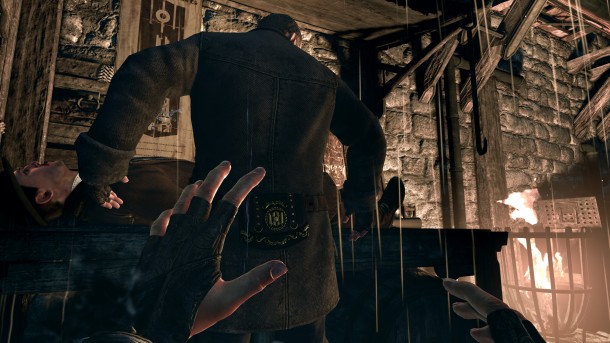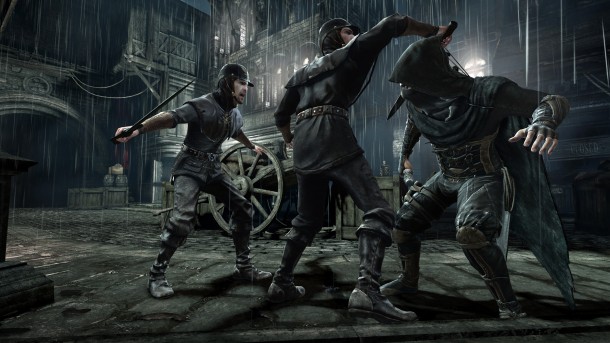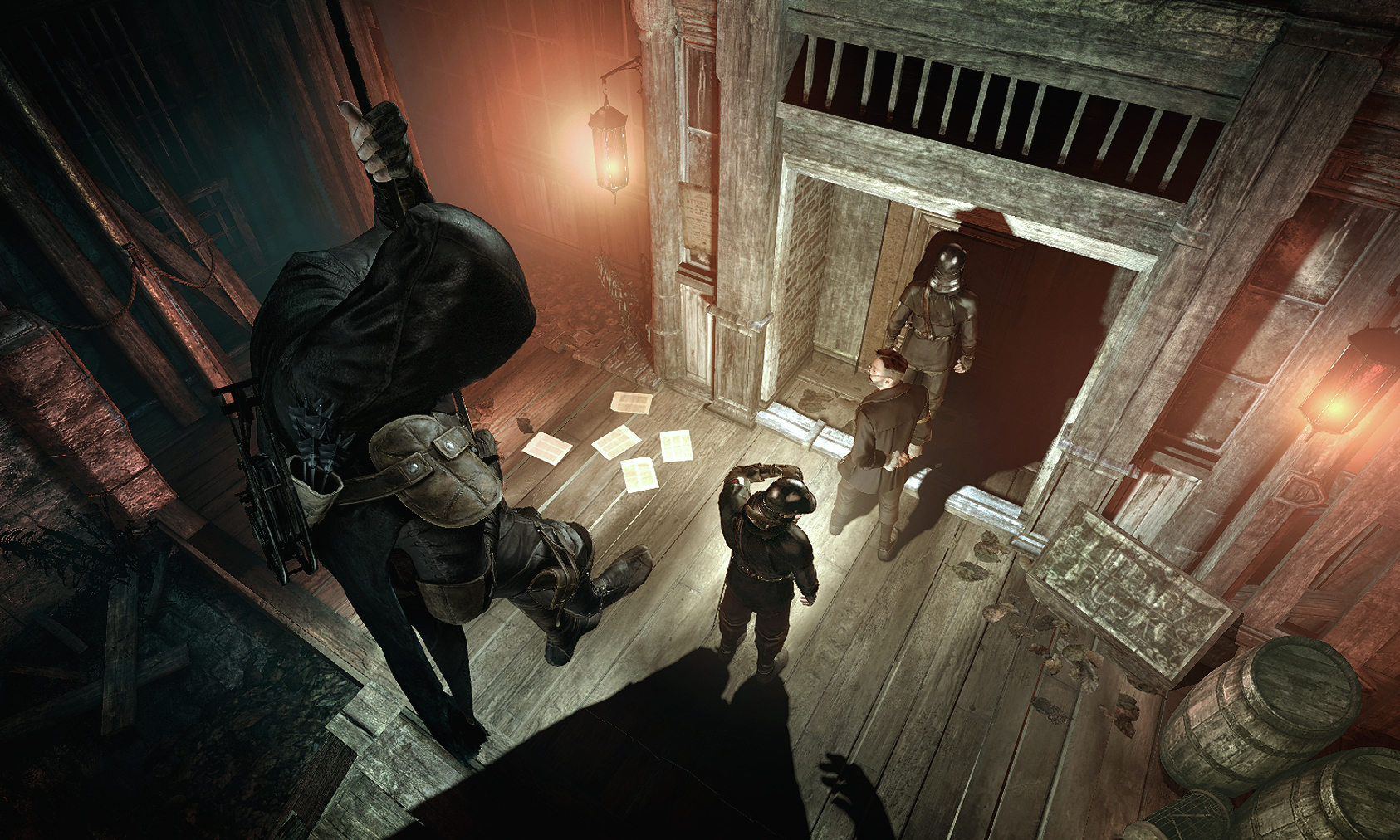Ten years after Thief: Deadly Shadows, the first-person stealth series gets the reboot treatment with the release of the singularly-titled Thief. Some of the classic elements and a few new ones are still there to hopefully provide an anchor to the original series for a new generation of fans. Thief, being gone so long, has a score to settle. Unfortunately, the score might not be attractive enough to please everyone.
The game’s story revolves around character Garrett and his urban playground, simply called The City. With the help of another thief named Erin, they attempt to steal from a group of cultists, but tragedy takes place and an unknown power is unleashed on The City. A year later, Garrett wakes up from a long and unexpected sleep to a new order in his world, full of watchguards and a disease named The Gloom. As he looks up old acquaintances, Garrett aims to figure out what happened.

The City itself resembles a mix of the cramped housing of the Middle Ages, narrow streets, and the rise of an industrial economy. It’s always bleak and gives this impression of an endless slum. Touring The City through the rooftops and streets should have been interesting, but even after playing the game for a while it still confuses me.
Though there’s a marker to indicate the location of a mission, it’s very easy to make your way there only to find a dead end, realizing that Garrett needs to go around to find the entrance to the next location. There are some paths and ledges that seem accessible, but they usually seem to be designed only to be reached through a certain route. This limits the open world feeling to just a few select paths indicated by scratches on a wall or grates glowing in a dark blue, signifying that they can be used to climb. Certain windows have a beam of light coming from them, letting Garrett know that he can enter the residence to steal objects. However, some of these windows are actually other doors to new locations, and it’s almost impossible to determine which ones are which unless you can look at the poorly designed map and figure them out.
This frustration is not just because of the lack of information but also the high frequency of loading screens due to The City being divided into small sections; enter a new area and a loading screen appears for 10-15 seconds. It’s really unfortunate that gameplay can be interrupted so often by the occurrence. It tarnishes the overall experience to the point where each mission can be easily reduced to a stop and go cycle.
As for progression, the game is divided into chapters, each containing a main treasure to steal in order to advance the story. Side missions and client jobs provide an alternative path to follow and allow for exploration, but were not challenging at all. The formula of breaking in, avoiding detection, stealing the treasure, and leaving is the backbone of the game, but there aren’t enough obstacles to make them a worthwhile feat.

Since Garrett’s a thief by trade, the preferred strategy would be stealth. This could be achieved by completely bypassing patrols and staying in the shadows, or sometimes knocking out or fighting guards to make a clear path to the target. Statistics at the end of each mission show how much of Garrett’s actions were stealthy, aggressive, or in between. It’s reminiscent of the grading system from Splinter Cell: Blacklist, but Thief‘s approach to different playstyles is just an illusion.
One encounter with a guard shows that direct combat doesn’t benefit Garrett. It’s not just about beating him into submission, but also about precise timing to dodge attacks. Even with upgrades, it’s easy to to get injured, and fighting multiple enemies is out of the question. It’s always a good idea to run and hide rather than stand and fight. It’s also pretty difficult to purposefully fight your way through guards, especially when they have the better weapons and armor.
Of course, Garrett can make the job slightly easier for himself by purchasing additional upgrades and ammunition for his arrow. The arrow bolts vary from traditional to water bolts that can extinguish small fires, or rope arrows to “unlock” an alternate route above the street. Garrett also has a Focus ability, similar to the Assassin Creed series’ Eagle Vision. He can use this to spot treasure and traps, and can be refilled by a poppy flower. Even with a vast library of arrow types and upgrades, I found myself sticking to a select few, since they were the best suited for every type of mission. It felt like the other selections were simply there to show variety.
On the PS4, which was used to review the game, the inventory is accessed with the front touch pad. It’s a cool idea that eliminates the need to pause the game to switch items, but it still needs work. It’s too sensitive and sometimes I needed to go all the way to the edge of the pad to reach items on the end of either row.

But the experience isn’t all bad. The mechanics of picking a lock or finding a switch are so simple, yet natural. A series of circles fills with light to indicate a switch or correct position to pick. Do it at the wrong time and Garrett’s blunder creates a loud noise, attracting anyone nearby. It’s great to see this small detail incorporated in the game and makes the steal slightly more fun.
The main missions are well executed and span large areas. There’s definitely room for multiple strategies to approach the target. There’s a good balance of enemies with enough to give Garrett pause and contemplate his route, but there’s also not a complete lack of them to make it too easy.
The guards in Thief are not the best AI I’ve seen, but they do a good enough job to make me think about my next few moves. Staying in a lit area will immediately attract their attention to investigate the movement or making too much noise, even when crouching will make them suspicious of their surroundings. This results in an even bigger emphasis on stealth, and their money pouches on their backs serve as a challenge to players to stay quiet and get as much as they can from everyone and everything.
Just because Garrett accepts the missions doesn’t mean he can’t stray off the beaten path. Various residences in The City can be accessed and Garrett can steal the contents inside. Usually it’s everyday items like a hand mirror, pen, or ring. Collectible items, like city plaques and a set of arm bracelets shaped like a snake, litter The City and might keep players busy by how well they are hidden, serving as trophies in Garrett’s hideout.
In the end, though, the bad outweighs the good in Thief. It’s not apparent at first, but spend enough time in The City and it’s bound to frustrate anyone. The sprawling, overcrowded world is an interesting backdrop to the mysterious events surrounding Garrett and it could have been well executed, but there’s just way too many things that need to be fixed to return Thief to its former glory.
This review is based on a retail copy of the game for the PlayStation 4 purchased by the reviewer.



No Comments